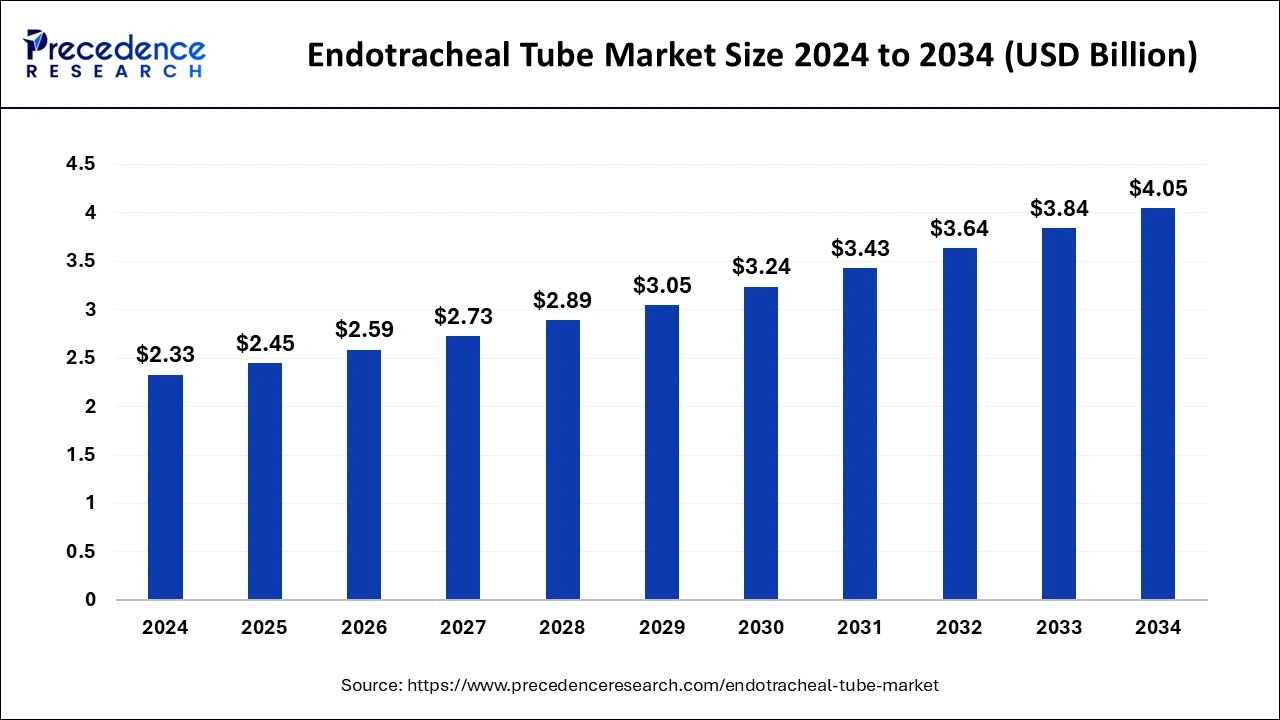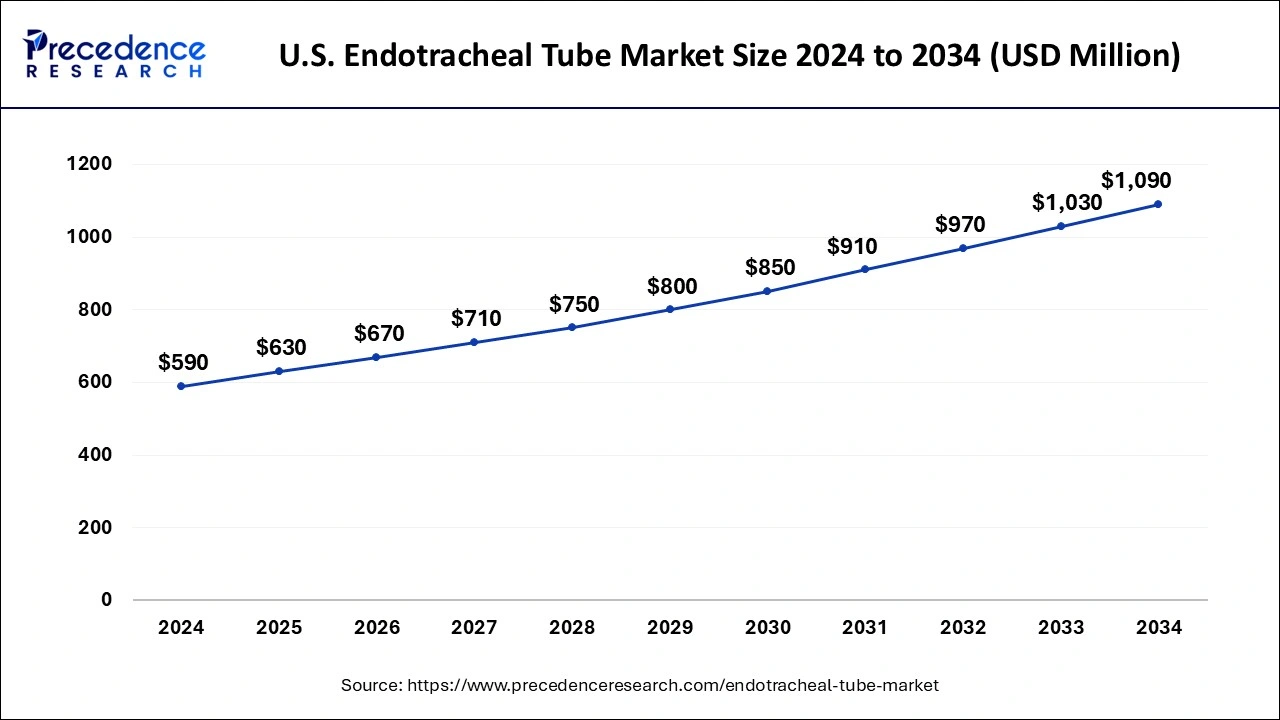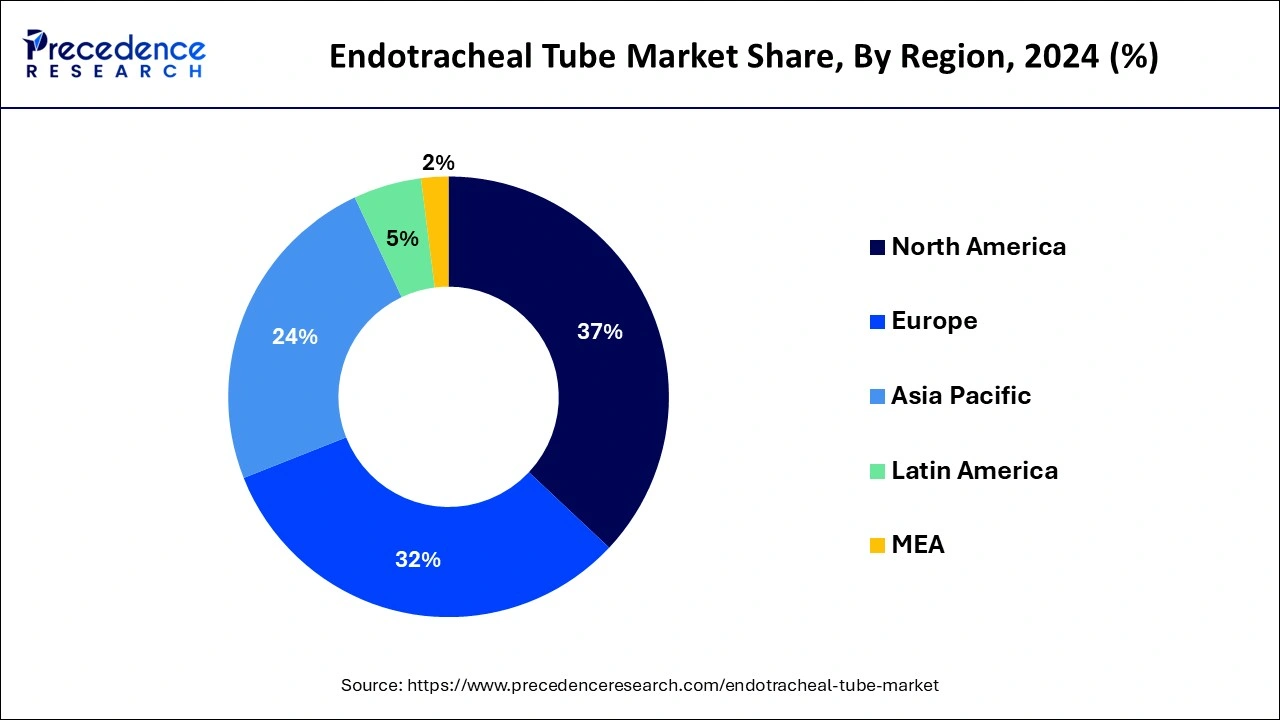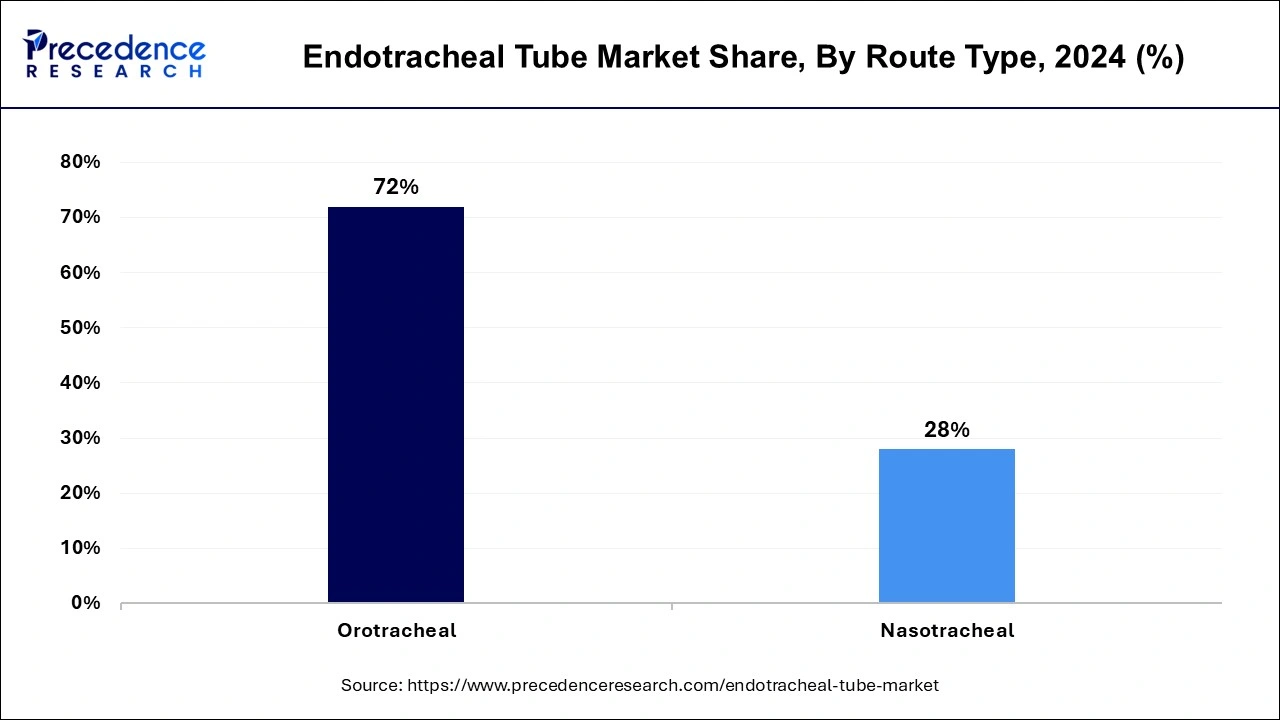List of Contents
Endotracheal Tube Market Size and Forecast 2025 to 2034
The global endotracheal tube market size was estimated at USD 2.33 billion in 2024 and is predicted to increase from USD 2.45 billion in 2025 to approximately USD 4.05 billion by 2034, expanding at a CAGR of 5.68% from 2025 to 2034.

Endotracheal Tube Market Key Takeaways
- North America contributed more than 37% of revenue share in 2024.
- Asia-Pacific region is estimated to expand at the fastest CAGR during the forecast period.
- By Product Type, the regular endotracheal tube segment has held the largest revenue share of 38% in 2024.
- By Product Type, the reinforced endotracheal tube segment is anticipated to grow at a notable CAGR of 7.8% during the projected period.
- By Route Type, the orotracheal segment captured the largest market share 72% in 2024.
- By Route Type, the nasotracheal endotracheal tube segment is projected to grow at the fastest rate over the projected period.
- By Application, the emergency treatment segment had the largest market share of 57% in 2024.
- By Application, the therapy treatment segment is expected to expand at the fastest rate over the projected period.
- By End User, the hospital segment captured the largest revenue share of 35% in 2024.
- By End User, the cyber security segment is predicted to grow at the fastest CAGR of 15.6% over the predicted period.
U.S.Endotracheal Tube Market Size and Growth 2025 to 2034
The U.S. endotracheal tube market size reached USD 590 million in 2024 and is anticipated to be worth around USD 1090 million by 2034, poised to grow at a CAGR of 6.33% from 2025 to 2034.

North America has held the largest revenue share 37% in 2024. In North America, the endotracheal tube market is witnessing notable trends. The region is characterized by a growing demand for advanced endotracheal tubes with features like cuff pressure control and real-time monitoring, reflecting a focus on patient safety and comfort. The increasing prevalence of chronic respiratory conditions, such as COPD, drives the market, along with a rising aging population requiring medical interventions.
Additionally, the COVID-19 pandemic underscored the importance of endotracheal tubes in critical care, leading to innovations in infection control and materials. Overall, North America continues to be a key market for endotracheal tubes with a strong emphasis on technological advancements and patient-centric solutions.

Asia-Pacific is estimated to observe the fastest expansion In the Asia-Pacific region, the endotracheal tube market is experiencing notable trends. The expanding healthcare infrastructure in emerging economies like India and China has significantly increased access to surgical procedures and critical care. This surge in healthcare services has driven a notable demand for endotracheal tubes in the Asia-Pacific region. As these countries develop their medical capabilities, the need for essential medical devices, including endotracheal tubes, is growing, marking a prominent trend in the market.
The region's aging population also contributes to the market's growth, as elderly patients often require intubation for various medical interventions, highlighting the increasing significance of endotracheal tubes in Asia-Pacific healthcare.
Market Overview
The endotracheal tube market encompasses the manufacturing and distribution of medical devices designed for artificial airway management. These tubes are inserted into the trachea through the mouth or nose, facilitating mechanical ventilation, anesthesia administration, and airway protection during surgery or critical care.
The market is characterized by a focus on patient safety, continuous innovation in tube design, materials, and coatings to minimize complications, and stringent regulatory compliance to ensure the efficacy and safety of these essential medical devices.
Endotracheal Tube Market Growth Factors
The endotracheal tube market involves the production and distribution of vital medical devices used for airway management. These tubes are inserted into the trachea, enabling mechanical ventilation, anesthesia delivery, and safeguarding of the airway during surgical procedures or critical care scenarios.
This market is defined by a commitment to patient safety, continual innovation in tube design and materials, and strict adherence to regulatory standards to ensure the reliability and safety of these indispensable medical tools.
Several noteworthy trends and growth drivers are shaping the endotracheal tube market, including the market is experiencing an increased demand for minimally invasive endotracheal tubes, which reduce patient discomfort and complications.
Furthermore, the rising incidence of chronic respiratory conditions, combined with an aging demographic, is bolstering the demand for endotracheal tubes in various medical settings, including emergency interventions and elective surgeries. Notably, the market is witnessing increased interest in advanced technologies, like smart endotracheal tubes embedded with monitoring functionalities, which are gaining widespread acceptance among healthcare professionals.
In this dynamic healthcare landscape, there are several business opportunities within the endotracheal tube industry. Companies can invest in research and development to create innovative tube designs that minimize complications and improve patient outcomes. Expansion into emerging markets, where healthcare infrastructure is growing, presents a lucrative growth avenue. Additionally, providing training and educational resources on proper intubation techniques can add value for healthcare professionals and foster brand loyalty.
Moreover, collaborations with healthcare institutions and research organizations can drive innovation and expand market presence. As the demand for reliable airway management tools continues to grow, the endotracheal tube market offers substantial potential for companies that prioritize safety, innovation, and regulatory compliance.
Market Scope
| Report Coverage | Details |
| Growth Rate from 2025 to 2034 | CAGR of 5.68% |
| Market Size in 2025 | USD 2.45 Billion |
| Market Size by 2034 | USD 4.05 Billion |
| Largest Market | North America |
| Base Year | 2024 |
| Forecast Period | 2025 to 2034 |
| Segments Covered | By Product Type, By Route Type, By Application, and By End Users |
| Regions Covered | North America, Europe, Asia-Pacific, Latin America, and Middle East & Africa |
Market Dynamics
Driver
Rising respiratory conditions and the aging population
The increasing prevalence of respiratory conditions like COPD and asthma is a significant driver for the endotracheal tube market. Chronic diseases often necessitate airway management and mechanical ventilation during episodes of exacerbation. With a global increase in the prevalence of respiratory conditions, the demand for endotracheal tubes, crucial for maintaining adequate airflow, oxygenation, and respiratory support, is on the rise. This surge in demand underscores the indispensable role these devices play in meeting the healthcare requirements of individuals with compromised respiratory health, emphasizing their significance in patient care and treatment.
Moreover, the aging population is a significant driver of increased demand in the endotracheal tube market. With growing age, individuals become more prone to various health challenges, often necessitating medical interventions and surgical procedures involving intubation. The increasing population of elderly patients undergoing elective surgeries and seeking respiratory support for age-related illnesses has significantly escalated the demand for endotracheal tubes. This demographic shift highlights the pivotal role these devices fulfill in meeting the healthcare requirements of an aging population, and this heightened demand is a driving force behind the growth of the endotracheal tube market.
Restraints
Alternative airway devices and complications
Alternative airway devices pose a restraint on the demand for endotracheal tubes in the medical market. Devices like supraglottic airway devices and video laryngoscopes offer less invasive and technically demanding airway management solutions, reducing the reliance on traditional endotracheal tubes in certain clinical scenarios. The availability of these alternatives challenges the dominance of endotracheal tubes, influencing healthcare providers' decisions and potentially limiting the market demand for these tubes, particularly in situations where ease of use and patient comfort are paramount.
Moreover, Complications associated with endotracheal tubes, such as tracheal damage, vocal cord injury, and infection risks, act as significant restraints on market demand. Healthcare providers may hesitate to employ these tubes due to the potential for adverse events, driving the search for alternative airway management devices with fewer complications. Minimizing these risks and enhancing patient safety are essential for maintaining and expanding the market's adoption, particularly in scenarios where complications can have severe consequences for patients' well-being and recovery.
Opportunities
Technological advancements and pediatric care
Technological advancements are driving increased demand in the endotracheal tube market. Innovative features such as real-time monitoring of cuff pressure, anti-microbial coatings, and enhanced materials are improving patient safety and comfort. Additionally, smart endotracheal tubes with advanced capabilities, like tracking patient data and facilitating precision intubation, are gaining favor among healthcare providers. As technology continues to enhance the efficacy and safety of these crucial medical devices, their adoption is on the rise, positioning them as integral components in modern healthcare, thus surging market demand.
Moreover, pediatric care plays a pivotal role in surging the demand for the endotracheal tube market. Children often require specialized, age-appropriate endotracheal tubes to address their unique anatomical needs during surgeries or critical care. The increasing pediatric healthcare sector and the presence of neonatal intensive care units (NICUs) drive the demand for these specialized tubes. Ensuring the availability of safe and effective intubation solutions for young patients is crucial, making pediatric care a significant driver in expanding the market's demand for pediatric-specific endotracheal tubes.
Product Type Insights
According to the product type, the regular endotracheal tube has held a 33% revenue share in 2024. A regular endotracheal tube is a fundamental medical device used for airway management by providing a secure passage for mechanical ventilation during surgeries, emergencies, and critical care. It consists of a tube with an inflatable cuff to create an airtight seal in the trachea, ensuring proper airflow and oxygenation. Recent trends in the endotracheal tube market include advancements in materials and coatings to reduce complications like ventilator-associated pneumonia (VAP).
Moreover, there's growing interest in incorporating smart technologies for real-time monitoring and enhanced patient safety. The demand for eco-friendly, sustainable materials and the development of specialized tubes for pediatric and neonatal care are also notable trends, reflecting the evolving dynamics of airway management in healthcare.
The Reinforced endotracheal tube is anticipated to expand at a significant CAGR of 7.8% during the projected period. A reinforced endotracheal tube is a specialized medical device used in airway management. It features an inner tube made of flexible material surrounded by an outer layer of reinforced material, often incorporating wire spirals or other reinforcement structures. This design provides enhanced resistance to kinking or collapsing, ensuring the patency of the airway during mechanical ventilation or anesthesia delivery.
Reinforced endotracheal tubes are gaining prominence in the market due to their ability to maintain airway integrity and minimize complications. Trends include the development of reinforced tubes with advanced materials and coatings to reduce the risk of cuff-related issues, infection prevention, and enhanced patient comfort. These innovations reflect a growing emphasis on patient safety and improved intubation outcomes in various clinical settings.
Route Type Insights
Based on the route type, orotracheal segment is anticipated to hold the largest market share of 72% in 2024. Orotracheal intubation, a route type in the endotracheal tube market, involves inserting a tube through the patient's mouth into the trachea. This technique is commonly used in various medical procedures and critical care scenarios. Recent trends indicate a growing preference for orotracheal intubation due to its ease of access and effectiveness in securing the airway. Manufacturers are focusing on designing endotracheal tubes optimized for orotracheal use, with features that enhance patient comfort and minimize complications, further driving the adoption of this route type in the market.

On the other hand, the Nasotracheal endotracheal tubes segment is projected to grow at the fastest rate over the projected period. Nasotracheal endotracheal tubes are a specific type of endotracheal tube inserted through the nose into the trachea. They are commonly used in various medical procedures, including surgeries and critical care scenarios. In the endotracheal tube market, there's a growing trend towards the use of nasotracheal tubes due to their advantages in certain clinical situations. These tubes can provide secure airway management while allowing better access to the oral cavity for dental and oral surgeries. The trend reflects a preference for versatility in airway management solutions to cater to diverse patient needs.
Application Insights
In 2024, the emergency treatment segment had the highest market share of 57% on the basis of the application. The emergency treatment segment of the endotracheal tube market involves the use of these medical devices in critical and time-sensitive situations, such as trauma care, cardiac arrest, or respiratory distress, where immediate airway management is vital. In emergencies, securing a patient's airway quickly and efficiently is crucial for delivering life-saving interventions.
Recent trends in this segment include the development of specialized emergency endotracheal tubes designed for rapid intubation, ergonomic packaging for easy access in emergency kits, and innovations in cuff technology to minimize the risk of aspiration. Additionally, there is a growing emphasis on training healthcare providers in rapid intubation techniques to improve response times during critical situations, further enhancing patient outcomes in emergency care scenarios.
The therapy treatment is anticipated to expand at the fastest rate over the projected period. Endotracheal tubes are essential medical devices used in airway management during various therapy treatments. They facilitate mechanical ventilation, anesthesia administration, and respiratory support. Recent trends in the endotracheal tube market include the development of specialized tubes for different therapies, such as pediatric care, neonatal care, and bariatric procedures. Additionally, advancements in tube materials and coatings enhance patient comfort and reduce complications. The market reflects a growing emphasis on therapy-specific customization, ensuring optimal patient care across diverse medical applications.
End User Insights
The hospital segment held the largest revenue share of 35% in 2024. Hospitals represent a vital end user in the endotracheal tube industry, as these medical facilities routinely employ endotracheal tubes for airway management during surgeries, emergencies, and critical care. Recent trends in this segment include a growing emphasis on patient safety, driving the adoption of advanced endotracheal tube designs with features like cuff pressure control and infection prevention coatings. Additionally, increased awareness of complications associated with intubation has led to efforts to streamline the intubation process, ensuring optimal patient outcomes and reducing complications in hospital settings.
The cyber security sector is anticipated to grow at a significantly faster rate, registering a CAGR of 15.6% over the predicted period. Clinics are key end user in the endotracheal tube market, utilizing these medical devices for a wide range of procedures, including minor surgeries, diagnostic interventions, and emergency care. These healthcare settings demand reliable and cost-effective endotracheal tubes, often in various sizes to accommodate diverse patient populations. The trend in clinics is shifting towards the adoption of single-use, sterile endotracheal tubes to enhance infection control and streamline procedures, aligning with the broader market focus on patient safety and operational efficiency.
Endotracheal Tube Market Companies
- Medtronic plc
- Teleflex Incorporated
- Smith's Medical (A Division of Smiths Group plc)
- C. R. Bard, Inc. (Becton, Dickinson and Company)
- Intersurgical Ltd.
- Medline Industries, Inc.
- Parker Medical
- Vyaire Medical, Inc.
- BOMImed
- Armstrong Medical
- Cook Medical
- Fuji Systems Corporation
- ConvaTec Group PLC
- KindWell Medical Equipment Co., Ltd.
- Teleflex Medical OEM
Recent Developments
- In 2022, Medtronic has successfully acquired Affera, enhancing its cardiac ablation portfolio. The addition of Affera's mapping and navigation platform complements Medtronic's offerings, providing an integrated system of diagnostic and therapeutic tools to effectively address a wide range of arrhythmias.
- In 2021, ICU Medical has successfully acquired Smiths Medical from Smiths Group plc. This strategic move integrates Smiths Medical's product range, including syringe and ambulatory infusion devices, vascular access, and vital care products, into ICU Medical's portfolio, establishing a dominant global infusion therapy company with expanded reach.
Segments Covered in the Report
By Product Type
- Regular Endotracheal Tube
- Reinforced Endotracheal Tube
- Preformed Endotracheal Tube
- Double-Lumen Endotracheal Tube
By Route Type
- Orotracheal
- Nasotracheal
By Application
- Emergency Treatment
- Therapy
- Others
By End Users
- Clinics
- Hospitals
- Ambulatory Surgical Centers
- Others
By Geography
- North America
- Europe
- Asia-Pacific
- Latin America
- Middle East and Africa
For inquiries regarding discounts, bulk purchases, or customization requests, please contact us at sales@precedenceresearch.com
Frequently Asked Questions
Ask For Sample
No cookie-cutter, only authentic analysis – take the 1st step to become a Precedence Research client